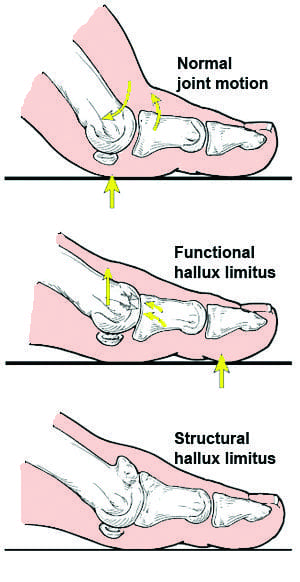Functional hallux limitus is a differential diagnosis from structural hallux limitus. Functional hallux limitus, or FnHL, is identified by the movement deficiency of the first metatarsophalangeal joint, found between the bones of the foot and of the toes, during gait. The first metatarsophalangeal, or MTP, joint reveals regular movements throughout an open kinetic chain evaluation. Radiographs may demonstrate a tiny amount of dorsal spurring of the joint, however, the joint doesn’t always necessarily demonstrate pervasive degenerative joint disease as an ultimate source of the health issue.
Structural hallux limitus, or SHL, is identified by structural adaptations of the first MTP joint which restrict ordinary movement from happening in the first place. These changes can be acute, with very limited dorsiflexion mobility, )hallux rigidus) or minor, (hallux limitus) leading to small changes in dorsiflexion of the first MTP joint. When normal foot insertion during propulsion is interrupted during MTP joint movement to prevent functioning of the foot construction through maximal hallux dorsiflexion over the effect of the windlass mechanism, the small changes can become considerably significant. In SHL, movement is going to be disrupted during open-and-closed-kinetic string actions. Pain and joint mobility is ultimately connected with any movement of the first metatarsophalangeal, or MTP, joint of the foot and of the toes.

Although the health issue itself is generally considered to be asymptomatic, the signs and symptoms of this condition can also be associated with a variety of other common pathologies of the foot, including heel pain, lesser metatarsal pain, Morton’s neuroma, Achilles tendon pain, and retrocalcaneal enthesitis as well as posterior tibial tendon dysfunction and postural alignment abnormalities of the lower back, or lumbar spine, and the lower extremities, including sciatica. Research studies have demonstrated that the prevalence of the disorder is much higher among the symptomatic population.
Table of Contents
Identifying Functional Hallux Limitus
Functional hallux limitus is unfortunately still considered to be a rare health issue which often goes unaddressed. Outcomes for many different foot disorders will be jeopardized if treatment doesn’t address functional hallux limitus. Foot and postural abnormalities have a basis in poor function of stabilization and the windlass mechanism of the foot structure through the plantar fascia. By way of instance, if this stabilizing effect is not present, it’s hypothesized that a range of foot disorders may result as normal foot function which cannot be achieved without appropriate purpose of the plantar fascia. Addressing the proper function of the foot has a high level of predictability for healing mechanically induced foot pain and this remains the goal of footbed and shoe modifications as the primary focus of orthotic intervention throughout many years in medicine.
Functional hallux limitus, or FnHL, is commonly diagnosed by a healthcare professional by detecting gait patterns and utilizing pedobarographic evaluations, which often require a qualified and experienced doctor or pricey equipment. The time consuming evaluations are also seldom able to be performed in the clinical setting. These challenges may probably contribute to the underdiagnosis of FnHL, or functional hallux limitus. Moreover, many healthcare professionals have also identified an FnHL evaluation demonstrated by the stiffening of large toe movement when implementing a loading force from the stage of maximal displacement to the first ray, especially when holding the foot and the toes in a neutral position.
When hallux dorsiflexion at the MTP joint is ultimately evaluated, there is a stiffening or bending movement of the MTP joint, when roughly equal power is applied to the hallux as is applied to the first metatarsal head. Healthcare professionals have demonstrated how several evaluations associated with visual gait evaluations have demonstrated that 72 percent of patients with a pronated midtarsal joint also had a positive evaluation for functional hallux limitus. Approximately 66 percent of patients with normal midtarsal joint motion had a negative test result. Healthcare professionals believe this to be a reliable test for the diagnosis of abnormal foot function. These type of evaluation have been conducted on asymptomatic individuals.
Functional Hallux Limitus and Sciatica
Functional hallux limitus is often commonly asymptomatic, therefore, it is rarely recognized as the functional inability of the first metatarsophalangeal, or MTP, joint to dorsiflex during gait. Normal movement is present in this joint during non-weight-bearing evaluations. Because the joint controls the pivot from which the entire body moves forward during each step, this disturbance in function, when repeated multiple times on a regular basis, can ultimately affect foot and postural biomechanics. It can also cause and aggravate many underlying health issues, including low back pain and sciatica. When functional hallux limitus is addressed in an orthotic treatment plan, 77 percent of long-term postural problem patients demonstrate 50 percent to 100 percent improvement in their overall health and wellness, among other health issues.
As soon as the diagnosis for FnHL has been made, the healthcare professional is going to want to address this health issue with the best treatment approach. Because this is a fundamental derangement of movement of the first MTP joint, conservative treatment is often successful and can be easily demonstrated in the foot evaluation. Surgery is seldom indicated. This is in contrast to structural hallux limitus, or SHL, which often does require surgical interventions to restore pain-free assortment of motion. FnHL is generally a misalignment of the first MTP joint in which the first metatarsal is dorsally displaced, restricting the average movement of the proximal phalanx in the first metatarsal head. It’s essential for a healthcare professional to accurately diagnose functional hallux limitus to follow-up with the proper treatment.

Because of the multifaceted nature of functional hallux limitus, understanding the health issue is ultimately fundamental for healthcare professionals and patients alike. Fortunately, there are many treatment approaches for functional hallux limitus depending on the nature of the pathology. As described above, functional hallux limitus is demonstrated as a normal range of hallux dorsiflexion during non-weight-bearing, however, there is a considerable decrease in hallux dorsiflexion. Functional hallux limitus has also been demonstrated to cause sciatica. – Dr. Alex Jimenez D.C., C.C.S.T. Insight
Fibromyalgia Magazine
The purpose of the article was to discuss the differential diagnosis in sciatica with a variety of health issues, including functional hallux limitus as well as structural hallux limitus, among others. Accurate diagnosis and proper treatment are important for the treatment of functional hallux limitus and low back pain or sciatica. The scope of our information is limited to chiropractic, musculoskeletal and nervous health issues as well as functional medicine articles, topics, and discussions. To further discuss the subject matter above, please feel free to ask Dr. Alex Jimenez or contact us at 915-850-0900 .
Curated by Dr. Alex Jimenez
Additional Topic Discussion: Severe Sciatica
Back pain is one of the most prevalent causes of disability and missed days at work worldwide. Back pain attributes to the second most common reason for doctor office visits, outnumbered only by upper-respiratory infections. Approximately 80 percent of the population will experience back pain at least once throughout their life. Your spine is a complex structure made up of bones, joints, ligaments, and muscles, among other soft tissues. Injuries and/or aggravated conditions, such as herniated discs, can eventually lead to symptoms of sciatica, or sciatic nerve pain. Sports injuries or automobile accident injuries are often the most frequent cause of painful symptoms, however, sometimes the simplest of movements can have these results. Fortunately, alternative treatment options, such as chiropractic care, can help ease sciatic nerve pain, or sciatica, through the utilization of spinal adjustments and manual manipulations, ultimately improving pain relief.
Formulas for Methylation Support
XYMOGEN’s Exclusive Professional Formulas are available through select licensed health care professionals. The internet sale and discounting of XYMOGEN formulas are strictly prohibited.
Proudly, Dr. Alexander Jimenez makes XYMOGEN formulas available only to patients under our care.
Please call our office in order for us to assign a doctor consultation for immediate access.
If you are a patient of Injury Medical & Chiropractic Clinic, you may inquire about XYMOGEN by calling 915-850-0900.
For your convenience and review of the XYMOGEN products please review the following link.*XYMOGEN-Catalog-Download
* All of the above XYMOGEN policies remain strictly in force.
Post Disclaimer
Professional Scope of Practice *
The information herein on "Understanding Functional Hallux Limitus" is not intended to replace a one-on-one relationship with a qualified health care professional or licensed physician and is not medical advice. We encourage you to make healthcare decisions based on your research and partnership with a qualified healthcare professional.
Blog Information & Scope Discussions
Our information scope is limited to Chiropractic, musculoskeletal, physical medicines, wellness, contributing etiological viscerosomatic disturbances within clinical presentations, associated somatovisceral reflex clinical dynamics, subluxation complexes, sensitive health issues, and/or functional medicine articles, topics, and discussions.
We provide and present clinical collaboration with specialists from various disciplines. Each specialist is governed by their professional scope of practice and their jurisdiction of licensure. We use functional health & wellness protocols to treat and support care for the injuries or disorders of the musculoskeletal system.
Our videos, posts, topics, subjects, and insights cover clinical matters, issues, and topics that relate to and directly or indirectly support our clinical scope of practice.*
Our office has reasonably attempted to provide supportive citations and has identified the relevant research study or studies supporting our posts. We provide copies of supporting research studies available to regulatory boards and the public upon request.
We understand that we cover matters that require an additional explanation of how it may assist in a particular care plan or treatment protocol; therefore, to further discuss the subject matter above, please feel free to ask Dr. Alex Jimenez, DC, or contact us at 915-850-0900.
We are here to help you and your family.
Blessings
Dr. Alex Jimenez DC, MSACP, RN*, CCST, IFMCP*, CIFM*, ATN*
email: coach@elpasofunctionalmedicine.com
Licensed as a Doctor of Chiropractic (DC) in Texas & New Mexico*
Texas DC License # TX5807, New Mexico DC License # NM-DC2182
Licensed as a Registered Nurse (RN*) in Florida
Florida License RN License # RN9617241 (Control No. 3558029)
License Compact Status: Multi-State License: Authorized to Practice in 40 States*
Presently Matriculated: ICHS: MSN* FNP (Family Nurse Practitioner Program)
Dr. Alex Jimenez DC, MSACP, RN* CIFM*, IFMCP*, ATN*, CCST
My Digital Business Card




